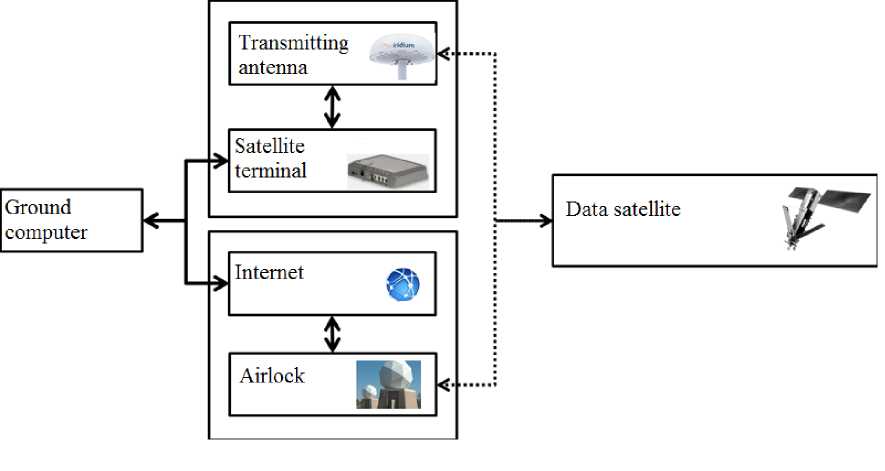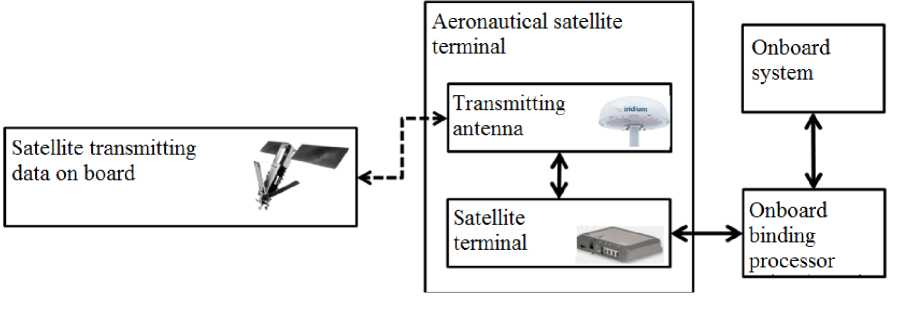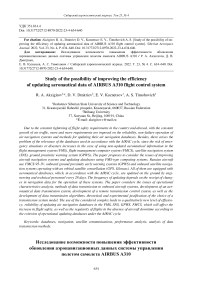Study of the possibility of im-proving the efficiency of updating aeronautical data of AIRBUS A310 flight control system
Автор: Akzigitov R.A., Dmitriev D.V., Kuznetsov E.V., Timohovich A.S.
Журнал: Siberian Aerospace Journal @vestnik-sibsau-en
Рубрика: Aviation and spacecraft engineering
Статья в выпуске: 4 vol.23, 2022 года.
Бесплатный доступ
Due to the constant tightening of flight safety requirements in the country and abroad, with the constant growth of air traffic, more and more requirements are imposed on the reliability, non-failure operation of air navigation systems and methods for updating their air navigation databases. Besides, there arises the problem of the relevance of the databases used in accordance with the AIRAC cycle, since the risk of emer-gency situations or disasters increases in the case of using non-updated aeronautical information in the flight management system (FMS), flight management computer system (FMCS), satellite navigation system (SNS), ground proximity warning system (GPWS). The paper proposes to consider the issues of improving aircraft navigation systems and updating databases using FMS-type computing systems. Russian aircraft use FMCS-95-1V, onboard ground proximity early warning systems (GPWS) and onboard satellite naviga-tion systems operating with an orbital satellite constellation (GPS, Glonass). All of them are equipped with aeronautical databases, which, in accordance with the AIRAC cycle, are updated on the ground by engi-neering and technical personnel every 28 days. The frequency of updating depends on the receipt of chang-es in navigation data for the operation of these systems. The paper considers the issues of operational characteristics analysis, methods of data transmission to onboard aircraft systems, development of an aer-onautical data transmission system, development of a remote transmission control system, as well as the development of data transmission algorithms, theoretical and experimental justification of the choice of a transmission system model. The use of the considered complex leads to a qualitatively new level of efficien-cy, reliability of updating air navigation databases in the FMS, SNS, GPWS, FMCS, which will affect the increase in flight safety, as well as the regularity of flights in the absence of aircraft downtime according to the criterion of operational updating databases under the AIRAC cycle.
Databases, navigation, satellite communications, performance analysis, analysis of data transmission methods
Короткий адрес: https://sciup.org/148329657
IDR: 148329657 | УДК: 351.814.4 | DOI: 10.31772/2712-8970-2022-23-4-634-640
Текст научной статьи Study of the possibility of im-proving the efficiency of updating aeronautical data of AIRBUS A310 flight control system
At the moment, area-type aeronautical databases in FMS systems are updated on the ground with compressed landing gear and this fact results in a number of disadvantages, such as downtime of the aircraft in the absence of a specialist and the aircraft being outside the base airport of deployment, the absence of database loaders. All this affects the regularity of flights, and, consequently, the economic component in terms of the timely execution of flights [1].
To solve this problem, it is necessary to analyze and find new technical and technological solutions for the purpose of timely, reliable, trouble-free updating of aeronautical databases in the considered FMS system [2]. To do this, it is necessary to:
-
1) analyze the operational characteristics and shortcomings of systems working with databases of the considered navigation systems;
-
2) analyze methods for transmitting data to aircraft systems, in this case AIRBUS-310, and opportunities for improving the process of updating FMS databases;
-
3) develop a system for transmitting aeronautical data from ground equipment to AIRBUS-310 onboard equipment with feedback;
-
4) develop a control system for the remote transmission of aeronautical data from the engineering update point from the ground to the AIRBUS-310 airborne loader with subsequent data uploading into
the FMS system and the possibility of requesting for data download from the AIRBUS-310 board to the update point [2];
-
5) develop data transfer algorithms, as well as data transfer control with their subsequent loading into the FMS AIRBUS-310 onboard system;
-
6) theoretically and experimentally substantiate the choice of a data transmission system model, as well as the choice of a satellite data transmission channel.
Suggestions for solving the problem
To solve the problems of operational planning of aircraft movement, as well as to obtain new information about changes in aeronautical data or flight during changing aeronautical information regulation and control, it is necessary to receive updated information on navigation data every 28 days at exactly 0:00 UTC. In addition to the practical need to promptly supply aircraft on-board systems with up-to-date information, there is the possibility of failures or errors in the DATA X database [3; 4]. Operational updating of navigation information is a necessary parameter for maintaining an acceptable level of flight safety.
In order to improve the performance of on-board information systems operating with databases, a data transmission system that allows for operational information support of on-board systems has been developed.
Let us consider the main components of the system, including the ground segment (Fig. 1) and the airborne segment (Fig. 2).
To update the aeronautical database on aircraft, AIRBUS-310 in particular, a laptop is used that has an RS-232 serial com input, which transmits aeronautical data in aviation format into the FMA system. The laptop on board the aircraft in the process of updating the database of the FMS system on the ground is the main working device that provides system control in general [5; 6].
In this case by the satellite terminal, we mean a transmitter for satellite communication systems that provides radio communication of a laptop on the ground with on-board equipment.

Fig. 1. Ground segment
Рис. 1. Наземный сегмент

Fig. 2. Onboard segment
Рис. 2. Бортовой сегмент
The data link in the system implies satellite communication operating through a gateway to create an information node of a satellite communication system or through a transmitting antenna. It is supposed that there will be three types of updates to the FMS database system: a periodic, a pre-flight and an operational one.
Types of Databases to Upgrade
The first type of an airborne database update, that is, a periodic update, is the database loading at regular intervals as needed by the international civil aviation organization. For the navigation database, the frequency required to reload it into the aircraft system is once per AIRAC cycle (28 days). Databases can set their own update times, but at least once every six months. In this case, the entire database in the onboard complex is replaced by an updated database [7].
The second type of an update - the pre-flight update - involves downloading data just before a flight and it includes only the flight data needed for that flight.
The third type of a navigation information update is an update at any time and in any place (in case of emergency situations, for example, when reinstalling the FMS system or losing the database).
Unlike the first and third types of updates, which preliminarily provide for a complete replacement of the database in accordance with ICAO requirements strictly within a certain period, the second type is designed to quickly download data that is relevant at the moment. Such data can include, for example, the main flight route (flight plan), another route, the flight region, some other navigation information required at the moment [8].
The aviation satellite terminal is a satellite radio modem, which is installed on board the aircraft.
Ways of database updating
The onboard communication processor is a special block computer that withstands overloads for successful operation on board the aircraft.
The database update system can be used in two modes.
The first mode consists in sending updated navigation data to the aircraft on-board system at the request of the ground air navigation service for flight support when new data arrives [9].
On the host computer the operator reads the database file directly from the website of the database developer. With the help of special applications, the database is selected at the regional level, after which the listed file is converted into the on-board system format. After that, it establishes a connection with the onboard processor, which works in the communication standby mode using ground and aviation subscriber terminals. The onboard communications processor switches to the ground computer command mode. At the command of the host computer, a coded transmission of a database with checksums is performed directly to the communication processor. The link processor sends checksums back to evaluate accuracy. If everything is normal, then the database download program is included in the on-board FMS system. In case of an error, the system transmits information to the ground segment and the data transmission process is repeated automatically. At the same time, after three unsuccessful attempts, a link error message is sent to the ground computer and the connection is terminated.
The second mode is sending the database to the aircraft at the request of the crew on board, if the database system is lost or rebuilt after repair work and works only in automatic mode.
In this mode, the main computer works in a standby mode, and the onboard binding processor enters the operating mode by the aircraft crew request. Further on, the process of transferring and downloading is similar to the previous one.
To solve the problem of ensuring the updates transmission, it is proposed to use satellite communication systems. At the moment, the four most suitable systems are relevant: Gonets, Globalstar, Inmarsat, Iridium [10; 11].
Taking into account the known systems transmitting digital data, the following data rates were modeled, which are expressed in bits/s for various radio stations:
– 600 b/s for DKMV radio stations;
– 2400-31000 b/s (VDL-2 mode) for MW radio stations;
– 9600 b/s for the “Globalstar” satellite system;
– 10.200-64.000 (Swift 64), 432.000 b/s for CCC Inmarsat;
– 128000-512000 b/s CCC Iridium NEXT.
Since the Iridium satellite system currently has the most potential, further work will allow calculating the average transmission time. It is proposed to use the following modification, as it is adapted for use in the aviation industry [12;13].
Calculation of average transfer time of 340 bytes using CCC Iridium NEXT:
M = 340 bytes = 2.72 Kb/s (maximum amount of data transferred);
V = 128–512 Kb/s (average data rate over SBD connection);
N = 1.5 s (average call setup time for an outgoing call).
T =--total transmission time of data packets, (1)
T 1.5 + 2.72
T =--------= 151 s.
150 t
Reliability of data transmission
When transmitting radiotelephone information in the Iridium network, the probability of an error per bit does not exceed 0.001; when transmitting digital information, it is 0.000001 [14–15].
Therefore, the probability of losing one bit of information when transmitting one data packet with a size of 340 bytes = 2.72 Kb/s will look like this:
P 1 = 2,72 x 103 x 10 - 6 = 0,00272. (3)
In case of an unsuccessful attempt to transmit data, the device retries data transmission up to three times, in which case the probability of an error during one working session is reduced.
The Iridium system has a high data transmission rate and a low error rate [16].
Conclusion
It can be concluded that, after analyzing the existing satellite communication systems as well as airborne data transmission systems, we proposed an option to update air navigation databases, transmitting all the necessary information in a continuous mode and in full, which requires experimental verification.
Список литературы Study of the possibility of im-proving the efficiency of updating aeronautical data of AIRBUS A310 flight control system
- Arnoult Sandra. Technology Achievement Award: Garmin International // Air Transport World. USA 2005. P. 40.
- Igoshin A. M. [Operational update of air navigation databases on aircraft]. Vestnik SibGAU. 2007, No. 2 (15), P. 49–5 (In Russ.).
- Korzhov V. V. [Multilevel client-server systems]. Networks (Network World). 1997, No. 6. Available at: https://www.osp.ru/nets/1997/06/142618.
- Rabiner L. Gould B. Тeoriya i primenenie tsifrovoy obrabotki signalov [Theory and application of digital signal processing]. Moscow, Mir Publ., 1978. 424 p.
- Abolits A. I. [Personal satellite communications]. IT Week. 1997, No. 18 Available at: https://www.itweek.ru/infrastructure/article/detail.php?ID=41652.
- Andrianov V. I., Sokolov A. V. Sredstva mobil'noy svyazi [Means of mobile communication]. St. Petersburg, BHV-St. Petersburg Publ., 1998, 256 p.
- Gabeidulin R. Kh., Goryachev D. I., Zubkova I. F. [Algorithmic and software support for an au-tomated system for planning the use of airspace in the GC EU ATM]. Nauchnyy Vestnik MGTU GA. 2010, No. 159, P. 121–127 (In Russ.).
- Firer P. O., Shinkevich S. M., Akzigitov A. R. [Analysis and improvement of the efficiency of satellite navigation systems and computer systems for aircraft navigation through timely updating of aeronautical databases]. Reshetnev Readings. 2014, Vol. 3 (In Russ.).
- Goldstein B. C. [Convergence of mobile and intelligent networks]. Vestnik svyazi. 2000, No. 4, P. 15–24 (In Russ.).
- Kalashnikov A. [Satellite personal communication system Globalstar]. Radio. 1997, No. 2, P. 68–69 (In Russ.).
- Nevdyaev L. CDMA: IS-95. Seti. 2000, No. 3 (In Russ.).
- Vorsano D. [Speech coding in digital telephony]. Seti i sistemy svyazi. 1996, No. 1, P. 84–87 (In Russ.).
- Sergeev A. S., Khoroshilov A. A., Dementiev A. V., Shutov A. S. [Components for object sur-faces]. Open systems. 2001, No. 1, P. 62–68 (In Russ.).
- Tamarkin V. M., Nevdyaev L. M., Sergeev S. I. Nizkoorbital'nye sistemy sputnikovoy svyazi [Low orbit satellite communication systems]. Moscow, Informsvyaz Publ., 1995, 96 p.
- Shiryaev A. [Low-orbit communication systems through the eyes of the consumer]. Tekhnologii i sredstva svyazi. 1997, No. 1 (In Russ.).
- Musin R. M., Akzigitov R. A., Andronov A. S., Peremyshlennikov V. V. [Improving the effi-ciency of data transmission in high latitudes]. Actual problems of aviation and astronautics. 2017, No. 13 (In Russ.).


